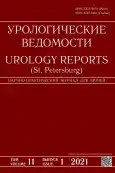Application of pantohematogen dry for treatment of discirculatory disorders in chronic prostatitis (experimental and clinical study)
- Authors: Tihonov I.V.1, Tityaev I.I.2, Kasyanov D.S.2, Chekushin R.H.3
-
Affiliations:
- Stankostroitel Sanatorium
- City Clinical Hospital No.1
- Kuzbass Clinical Dermatovenerogical Dispensary
- Issue: Vol 11, No 1 (2021)
- Pages: 63-68
- Section: Original study articles
- Submitted: 16.11.2020
- Accepted: 09.01.2021
- Published: 27.05.2021
- URL: https://journals.eco-vector.com/uroved/article/view/50229
- DOI: https://doi.org/10.17816/uroved50229
- ID: 50229
Cite item
Abstract
PURPOSE: To study in experiment and in clinical conditions the effectiveness of the preparation pantogematogen dry, obtained from the blood of a maral, for the correction of dyscirculatory disorders in the prostate gland.
MATERIALS AND METHODS: The experimental and morphological part of the work was performed on 90 male Wistar rats with local venous congestion in the small pelvis due to ligation of the internal iliac veins. Animals of the main group (n = 30) underwent enteral correction with dry pantohematogen (in a daily dose of 10 mg per 100 g of animal weight) starting from the 7th day after modeling the disease, the course was 14 days. The rats of the 2nd group (n = 30) after modeling of venous stasis were not treated. Group 3 consisted of intact animals. During the clinical phase of the study, 61 patients with chronic congestive prostatitis were treated. All patients received standard therapy, and patients in the treatment group (n = 30) additionally received highly dispersed aerosol transrectal irrigation with an aqueous solution of pantohematogen, daily, for a course of 10 procedures.
RESULTS AND DISCUSSION: Morphological examination of the prostate gland of laboratory animals with experimental discirculatory prostatitis and its subsequent enteral correction with panthematogen dry indicated significant differences compared with animals of the 2nd group. A tendency towards restoration of the normal structure of the prostate, its metabolism, regional and organ blood and lymph outflow, improvement of the drainage-detoxification and transport activity of its regional lymph nodes was noted. In the clinical part of the study, the effectiveness of the use of pantogematogen in patients with chronic congestive prostatitis was shown. At the end of the course of treatment in patients of the 1st group, the disappearance of pain (in 72.4% of cases) and dysuric (in 86.2% of cases) syndromes was observed, and in the rest – a decrease in their intensity. According to the TRUS of the prostate in patients of the 1st group, after treatment in 52% of cases, a decrease in the volume of the prostate was noted.
CONCLUSIONS: The results of an experimental clinical study indicate the prospects for the inclusion of pantogematogen in the complex therapy of patients with chronic congestive prostatitis.
Full Text
About the authors
Igor V. Tihonov
Stankostroitel Sanatorium
Email: tihonoff2701@yandex.ru
Doctor of Medical Science, Medical Director, Urologist
Russian Federation, 656045, Altay region, Barnaul, Tihonova street, 33BIgor I. Tityaev
City Clinical Hospital No.1
Email: den-sk@ya.ru
Doctor of Medical Science, Professor, Urologist of Urology Department
Russian Federation, 630047, Novosibirsk, Zalesskogo street, 6Denis S. Kasyanov
City Clinical Hospital No.1
Author for correspondence.
Email: kasyanovds@mail.ru
Urologist, Oncologist of the Outpatient Care Center
Russian Federation, 630047, Novosibirsk, Zalesskogo street, 6Ramil H. Chekushin
Kuzbass Clinical Dermatovenerogical Dispensary
Email: kasyanovds@mail.ru
Dermatovenerologist, Candidate of Medical Science
Russian Federation, 650025, Kemerovo, Rukavishnikova street, 41References
- Bozhedomov VA. Modern opportunities for the treatment of chronic prostatitis. Andrology and Genital Surgery. 2016;17(3):10–22. (In Russ.) doi: 10.17650/2070-9781-2016-17-3-10-22
- Molochkov VA, Il’in II. Hronicheskij uretrogennyj prostatit. Moscow: Medicina; 2010. 304 p. (In Russ.)
- Kubanova AA, Vavilov AM, Volnuhin VA, et al. Racional’naya farmakoterapiya zabolevanij kozhi i infekcij, peredavaemyh polovym putem / Ed. by A.A. Kubanova. Moscow: Litterra, 2007; 512 (In Russ.)
- Paulis G. Inflammatory mechanisms and oxidative stress in prostatitis: the possible role of antioxidant therapy. Res Rep Urol. 2018;17(10):75–87. doi: 10.1007/978-3-319-71282-6_4
- Dendeberov ES, Logvinov LA, Vinogradov IV, et al. Taktika vybora skhemy terapii bakterial’nogo prostatita. Russian Medical Journal. 2011;19(32): 2071–2074. (In Russ.)
- Kulchenko NG, Yatsenko EV. Phytotherapy for inflammatory diseases of the prostate. Research and Practical Medicine Journal. 2019;6(3):87–97. doi: 10.17709/2409-2231-2019-6-3-8
- Vermassen T, Van Praet C, Poelaert F, et al. Diagnostic accuracy of urinary prostate protein glycosylation profiling in prostatitis diagnosis. Biochem Med (Zagreb). 2015;25(3):439–449. doi: 10.11613/BM.2015.045
- Suskind AM, Berry SH, Ewing BA, et al. The prevalence and overlap of interstititial cystitis/bladder pain syndrome and chronic prostatitis/chronic pelvic pain syndrome in men: results of the RAND Interstitial Cystitis Epidemiology Male Study. J Urol. 2013;189(1):141–145. doi: 10.1016/j.juro.2012.08.088
- Pushkar DYu, Rasner PI, Kotenko DV, et al. Specific features of lower urinary tract symptoms in men living in the moscow region. Results of the epidemiological study. Urology. 2018;(3):20–23. (In Russ.) doi: 10.18565/urology.2018.3.20-28
- Shpienya ES. Klassifikaciya UPOINT: osobennosti i preimushchestva. Vestnik Rossijskogo obshchestva urologov. 2019;(2):10. (In Russ.)
- Segal AS. Diagnostika i lechenie hronicheskogo prostatita. Russian Medical Journal. 2003;11(8):453–458 (In Russ.)
- Kozlov BI, Popova IS. Pantolechenie. Posobie dlya vrachej i farmacevtov. Barnaul; 2014. 44 p. (In Russ.)
- Lazareva VA. Primenenie pantogematogena v kompleksnom lechenii bol’nyh hronicheskim prostatitom. Metodicheskoe posobie dlya vrachej. Novosibirsk; 2007. (In Russ.)
- Tihonov IV. Effektivnost’ ispol’zovaniya biologicheski aktivnoj dobavki k pishche “Fitopan M” v kompleksnoj sanatornoj reabilitacii bol’nyh hronicheskim prostatitom. Aktual’nye problem vosstanovitel’noj mediciny, kurortologii I fizioterapii: Sbornik nauchnyh trudov Vserossijskogo foruma “Zdravnica”. Saint Petersburg, 2004; P. 245. (In Russ.)
- Tihonov IV. Regional’nye limfaticheskie uzly predstatel’noj zhelezy v norme, pri venoznom zastoe v malom tazu i v usloviyah fizio- i fitokorrekcii: [dissertation] Novosibirsk; 2008. (In Russ.) Available from: http://medical-diss.com/medicina/regionarnye-limfaticheskie-uzly-prostaty-v-norme-pri-venoznom-zastoe-v-malom-tazu-i-v-usloviyah-fizio-i-fitokorrektsii.
- Avcyn AP, ZHavoronkov AA, Rish MA, Strochkova LS. Mikroelementozy cheloveka. Moscow: Medicina; 1991. 496 p. (In Russ.)
- Borodin YuI, Konenkov VI, Poveshchenko AF, editors. Problemy limfangiologii. Novosibirsk: Manuskript; 2010. 403 p. (In Russ.)
Supplementary files











